TMJ anatomy
TMJ anatomy takes you on a grand tour of this complex joint that causes such severe pain and migraine headaches.
This page is not designed to be a highly academic tour of this complex joint; however it is a difficult topic that has had chiropractors scratching their heads.
The sensory nucleus of the large nerve that supplies the jaw is located in the cervical spine, and hence the strong connection between migraine headache, neck and facial pain.
It will give you some insights if you can struggle with the anatomy, and provide some understanding of how the temporo mandibular joint can cause severe problems.
- Facial pain
- Migraine headaches
- Referral to the upper neck
- Tinnitus or ringing in the ears
- Clicking, popping and locking of the jaw joint.
It is also the joint that contributes to a complex and extremely debilitating condition called trigeminal neuralgia. You can go to our TMJ ear pain page for more information.
Shall we sully forth on our TMJ anatomy tour? It
will help you understand any jaw joint symptoms you may be having and how it
can cause such misery.
Two cranial structures form the joint.
- The temporal bone lies on the side of your head. It has a neat little socket into which the jaw fits.
- The mandible is the anatomical name of the jawbone.
Hence temporo-mandibular and then, of course, joint to get TMJ.
TMJ anatomy
TMJ anatomy will help you understand in layman's terms what this joint is about and why it can cause so much migraine and facial pain.
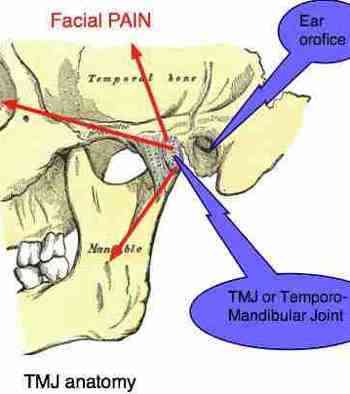
The pterygoid pocket is a cul de sac behind the upper molars; it can be very painful.
This picture is taken from a book called Grays Anatomy. Come back later and take a short tour about this amazing man. A real pioneer.
Click here for more about Henry Gray's Anatomy tour.
Notice the mandible has two prongs.
- The posterior prong (hidden in the picture above behind some ligaments which hold the mandible firmly in place) fits snugly into a hollow in the Temporal bone, just in front of the ear.
- The anterior prong is for the attachment of the Temporalis, the main biting muscle; it covers the side of the head. See how much leverage this gives it? Hence its awesome power.
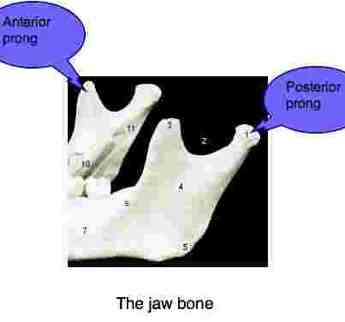
TMJ muscles
Two powerful TMJ muscles can be seen on the side of the face.
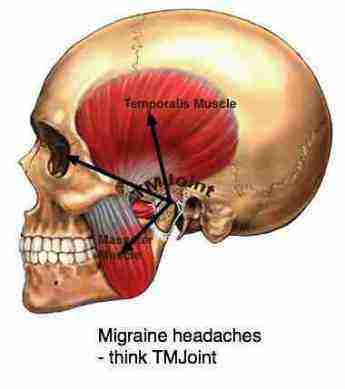
Henry Gray's anatomy remains the most revered and respected tome on the subject; he achieved so much in a very short life.
Notice two features in this second picture of our temporo-mandibular joint anatomy tour.
The actual joint where the posterior prong fits into a socket in the temporal bone.
The three muscles that slam the jaw closed.
- The huge flat temporalis muscle that is attached to the other prong (or condyle), and another jaw closer,
- The masseter muscle.
- The third, the internal pterygoid we'll come to later.
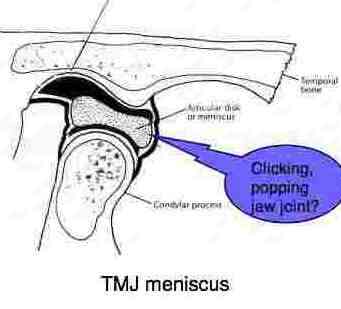
A very powerful trio, strong enough to bite your own finger off, literally. As we will see in due course, these muscles can contribute to your headache and facial pain, and the neck too if the temporo mandibular joint is not functioning as it should.
You will discover four primary jaw muscles on your tmj anatomy tour. They open, close, protrude and move the jaw sideways, enabling you to talk, chew, and swallow, kiss and many other things we do with our mouths. We'll come to the fourth muscle in due course.
There are three kinds of tmj anatomy pain:
1. Primary muscle discomfort is not really common but overuse, as in chewing gum or in South Africa, biltong, in association with disc malfunction can commonly causes jaw, facial and sometimes neck pain, as well as headache.
If the jaw joints are functioning optimally then muscle overuse is not usually a problem. But if they are not moving in sync then the more you chew, the greater the problem.
2. The important feature on this leg of our TMJ anatomy tour is the disc, or meniscus as it is known, that rides in the joint, which functions as a moving shock absorber between the condyle and the fossa, or, socket, separating the two bony structures.
It's unique, quite different to any other joint in the body. As you open your jaw, the condyle first rotates and then slides forward in the fossa.
When the disc malfunctions, often after the jaw has been opened too wide, or taken a blow as in a punch, then it gives the familiar clicking and popping sound so often associated with temporo mandibular joint pain.
Please do not slap your child's face, your spouse or even your enemy. You may just cause them a lifetime's temporo mandibular joint anatomy pain.
3. Joint related pain may occasionally result from inflammation, as in rheumatoid arthritis but more usually from degeneration of the tissues within the temporo mandibular joint.
This wear and tear in the joint, and dislocation of one of the menisci, are the two most common disorders of the TMJ. They then no longer work together in harmony causing facial pain, jaw discomfort and migraine headache.
And referred pain to the upper neck.
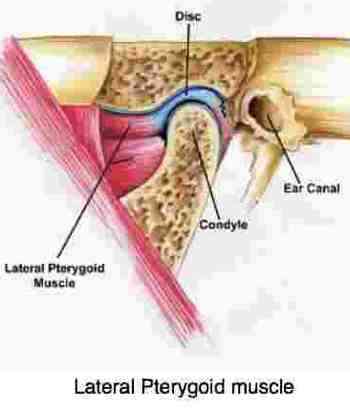
Note two things here. How the condyle (posterior prong) sits in its fossa, and the position of the normal disc. Can you see how it is attached another very important muscle, the lateral pterygoid?
Because of this attachment to the disc the lateral pterygoid muscle can become supremely, exquisitely and extremely painful when dysfunctional.
This is the muscle that opens the jaw, pulling the condyle forwards out of its fossa, protected by the disc from grinding on the bone. Used on one side only, it moves the jaw from sideways when chewing the cud.
Juggle your jaw from one side to the other; that's the Lateral Pterygoid you are using.
Now protrude the jaw, push it forwards. That's the two Lateral Pterygoids working together. See in the next picture how the condyle has slid forwards out of its fossa? That is normal.
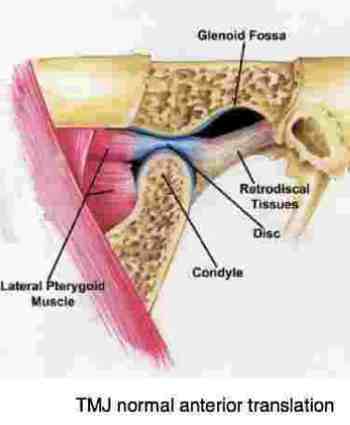
Dislocated disc (meniscus)
Notice in the next picture how the disc has been displaced forwards. This is definitely not normal. Should you now open your jaw there will be a popping sound as the it pops back behind the prong of the condyle.
When this popping happens repeatedly the disc starts to wear and sets up a pain pattern in the muscles around the jaw joint.
Try placing the pads of your index fingers in your ear and slowly open your mouth. Do they open nicely together? Are there any clicks or pops?
Often patients are terrified of words like disease and degeneration sometimes used in describing this wear-and-tear process. No need, it's no different to your hair turning grey. What is now clearly recognised in the literature though is that, untreated, joint malfunctions, or fixations as we call them, lead to unnecessary, premature degeneration.
Every time the displaced disc has to pop over the condyle, it is probably equivalent in terms of wear and tear to 100 openings of a healthy jaw.
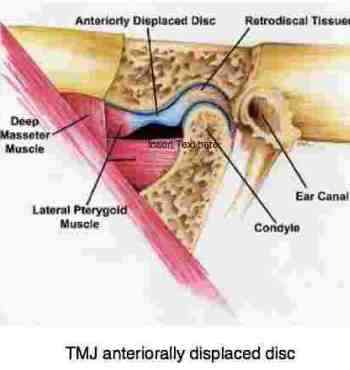
Trigeminal Neuralgia
This information about the jaw joint, its position, clicking and pain is then fed back to the brain via the largest cranial nerve, the Trigeminal which supplies the face and has a spinal sensory nucleus deep in the neck.
This is the mechanism whereby the irritation from a clicking jaw can cause facial pain and be referred to the neck.
It is the reason why sufferers also usually have upper neck pain; temporomandibular neuralgia is a more complex syndrome, with the nerve being irritated deep in the skull before emerging. In true cases, there are no TMJ anatomy signs like clicking jaw joints.
This facial pain can be very severe and is sometimes set off by a stimulus as slight as brushing the cheek or a breath of wind.
Can you see that long black structure in the picture below? In the next picture it's highlighted in green. That is the huge trigeminal nucleus extending right down into the spinal cord in the neck.
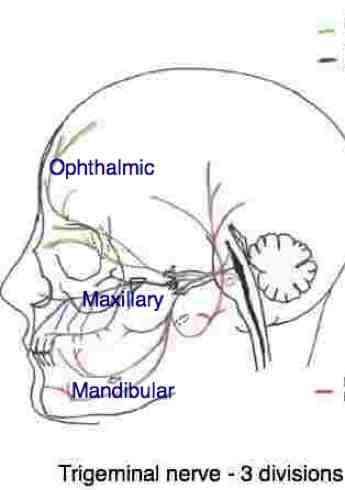
Facial Pain
It's called the TRI-geminal nerve, because it has three different sensory branches, seen here in green, blue and brown, supplying primarily the face, teeth and sinuses; and the TMJ anatomy. It is by far the largest cranial nerve and a major cause of facial pain.
Whilst I don't want to overdo the complexity of TMJ anatomy, this next slide will show you how it can provoke neck pain and perhaps CAUSE subluxations; and how fixations in the cervical spine can make the jaw joint vulnerable to injury.
On the right hand side you have the four functions of the Trigeminal nerve. Focus only on the one labelled "Pain and Temperature." If you follow it along the "Spinal Trigeminal Tract" you will see that its sensory nucleus.
It is called the "Spinal Trigeminal nucleus" and is located right down in the neck. From there a dark-coloured tract reaches up into the sensory cortex of the brain (those two dark arrows) where the pain is perceived.
So noxious pain and temperature signals from the TMJ feed right down into the neck, where they meet up with other nerves from the spine, swapping messages.
Enough, right? Well done, you're a perseverer if you got this far. There is nothing simple about TMJ anatomy.
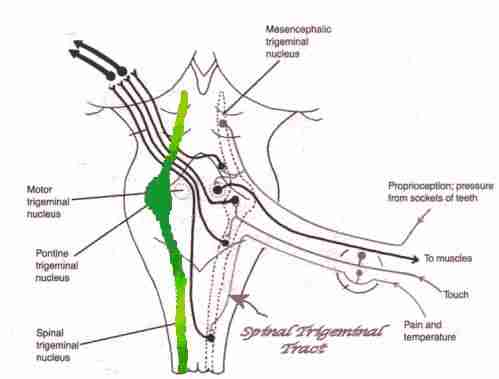
There's nothing simple about the human body and certainly not the TMJ anatomy. "Fearfully and wonderfully made" as one great surgeon named his book.
I said there are four jaw muscles. The fourth, the Internal Pterygoid is also a jaw closer. I include it here, partly for completeness, but also so that you can see the four branches of the Trigeminal nerve in situ.
One motor branch to the muscles of the jaw, and three sensory nerves (labelled 1st Div, 2nd and 3rd).
Can you see their proximity to the Internal Pterygoid? This is why jaw muscle pain can so readily become intense nerve pain.
For anatomy students only: Can you see the tiny branches supplying the Tensor Tympani muscle in the inner ear? It dampens overly loud sounds.
And the Tensor Veli palatini muscle that has two vital functions; in swallowing it helps raise the soft palate so food doesn't enter the sinuses, and opens the auditory tube, allowing for equalising the pressure between the inner ear and the outside air. Vital for example when driving up a steep hill, or ascending in an aeroplane.
That pop in the ear is the Tensor Veli Palatini doing its job.
So the very complex fifth cranial nerve, the Trigeminal, is almost continuously in use in chewing, speaking and swallowing; in hearing and bringing sensory information from the teeth, face and jaw joints to the brain too.
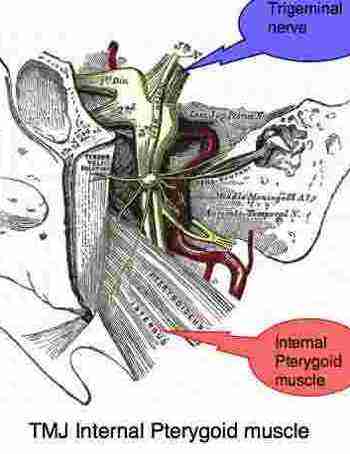
Jaw pain is of course one of the symptoms of an impending myocardial infarction. Interesting research published in JAMA states that almost 50% of these cardiovascular conditions are caused either by a deficiency of certain foodstuffs, or overindulgence in certain toxic meals. Read more about how you can prevent heart, stroke and diabetes.
Tinnitus
Not a pain, but there is an irritating condition, sometimes it becomes extreme ringing in the ears, that is common and occasionally associated with vertigo; and sometimes a result of a TMJ anatomy problem. But not usually, alas. But if you have crackling sounds, pain and stiffness coming from your jaw, then your tinnitus may be coming from the temporomandibular joint. If there is hearing loss, then Meniere's disease also needs to be considered.
Vertigo, similar to but not quite the same as dizziness, is a dreadful condition that we will consider elsewhere at Chiropractic Help.
Read about it in a chapter about BPPV at vertigo dizziness .
Chiropractic
Like all other chronic joint conditions there is no real permanent cure for TMJ anatomy wear and tear; not with chiropractic either. An acute pain or click which has just begun, correctly addressed should pass over, and the trick is not to allow it to continue indefinitely.
Like any other condition, once you know it's not going to get better on its own, then it is better to contact the relevant health professional sooner rather than later.
Not unlike the neck and back, good care of chronic TMJ pain aims at reducing the ache and facial pain, restoring normal function and avoiding known factors that provoke symptoms; like biting a whole apple and chewing gum.
The pain and dysfunction is often temporary, lasting a few days or weeks, even a month or two perhaps, so adventurous surgery which cannot be reversed should only be contemplated when all else has failed. Your first port of call, of course should be your chiropractor.
I have done no research in my practice, but I would guess at least 75 percent of patients have good to excellent results with chiropractic treatment of the TMJ.
What will your chiropractor do? Firstly a good history of how the
pain or clicking started, how long it's been there and what aggravates it; whether you are getting headaches, and any of the sharp
stabs associated with trigeminal neuralgia. Are there any definite sinus symptoms?
Then there will be an examination of the TMJ anatomy and your neck. Treatment will include mobilising the joint and acupressure of any active trigger points; and stretching of the muscles and joint capsule.
So, what's the good news? This is a very treatable condition. You do not have to live with TMJ anatomy pain for months.
Is there any bad news? If the pterygoids have active trigger points, they can only be reached from inside the mouth, and the treatment may be wretchedly painful, sometimes lasting a few days. Hang in with your chiropractor; that too will pass. It's very effective.
TMJ exercises
What can you do for yourself? Are there any jaw exercises for TMJ? An ice block rubbed directly on the painful spot, followed by moist heat; do it in the shower. Now that you've taken your TMJ anatomy tour, you know where to find these muscles, right? Gently massage them. Your chiropractor will give you some stretches and, for more tips about TMJ exercises, scroll down.
If appropriate, your chiropractic treatment may include cervical spine adjustments too, if there are associated fixations. For more about the neck adjustments, scroll down to neck pain treatment.
For an interesting case from the coalface, click on this link and scroll down to Mrs Hol. Chiropractic Coalface ...
There is a tool for self treatment of the internal pterygoid muscle; I regret I've seen no research on how effective it is, but you might like to try it; you will find it at this natural treatment for tmj page.
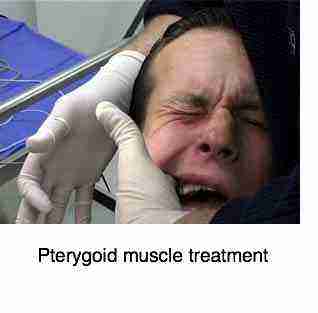
Migraine headache
Interestingly research shows that migraine headache sufferers clench their Temporalis muscles 14x more often; the TMJ anatomy is often involved.
More about Migraine headache / TMJ headaches.
TMJ anatomy can cause a minefield of painful conditions.
In short Head Neck pain is a complex subject with many triggers for migraine headaches. For example, the atlanto occipital joint upper cervical spine discomfort often goes with TMJ ear conditions and migraine too.
This whole process of TMJ dysfunction leading to migraine headache and facial pain often has roots going back to wisdom teeth extraction for infection under general anaesthetic; the mouth is opened too wide with the patient unable to protest.
Our recommendation is that there needs to be very good reason not to have them out with a local anaesthetic.
Important considerations
- From the beginning of the alimentary canal to the end. Beetroot constipation ... One of the pages with a very high hit rate at Chiropractic-Help.com
- TMJ treatment tool
When browsing these links use right click and "Open Link in New Tab", or you may get a bad gateway signal.
- Home
- TMJ
Did you find this page useful? Then perhaps forward it to a suffering friend. Better still, Tweet or Face Book it.
